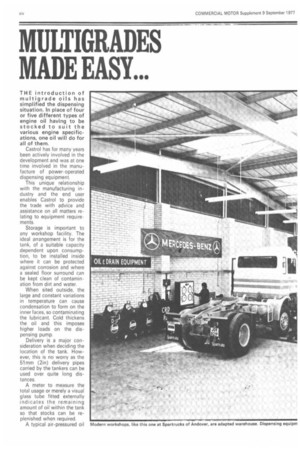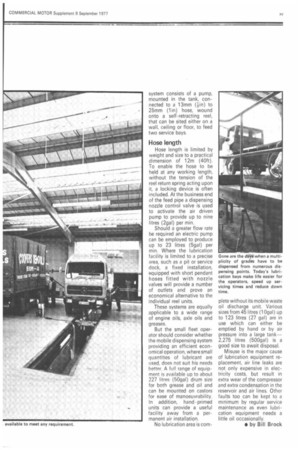MULTIGRADES MADE EASY...
Page 62

Page 63

If you've noticed an error in this article please click here to report it so we can fix it.
THE introduction of multigrade oils has simplified the dispensing situation. In place of four or five different types of engine oil having to be stocked to suit the various engine specifications, one oil will do for all of them.
Casual has for many years been actively involved in the development and was at one time involved in the manufacture of power-operated dispensing equipment.
This unique relationship with the manufacturing industry and the end user enables Castrol to provide the trade with advice and assistance on all matters relating to equipment requirements.
Storage is important to any workshop facility. The ideal arrangement is for the tank, of a suitable capacity dependent upon consumption, to be installed inside where it can be protected against corrosion and where a sealed floor surround can be kept clean of contamination from dirt and water.
When sited outside, the large and constant variations in temperature can cause condensation to form on the inner faces, so contaminating the lubricant. Cold thickens the oil and this imposes higher loads on the dispensing pump.
Delivery is a major consideration when deciding the location of the tank. However, this is no worry as the 51mm (2in) delivery pipes carried by the tankers can be used over quite long distances.
A meter to measure the total usage or merely a visual glass tube fitted externally indicates the remaining amount of oil within the tank so that stocks can be replenished when required.
A typical air-pressured oil system consists of a pump, mounted in the tank, connected to a 13mm (bin) to 25mm (1n) hose, wound onto a self-retracting reel, that can be sited either on a wall, ceiling or floor, to feed two service bays.
Hose length
Hose length is limited by weight and size to a practical dimension of 12m (40ft). To enable the hose to be held at any working length, without the tension of the reel return spring acting upon it, a locking device is often included. At the business end of the feed pipe a dispensing nozzle control valve is used to activate the air driven pump to provide up to nine litres (2gal) per min.
Should a greater flow rate be required an electric pump can be employed to produce up to 23 litres (5gal) per min. Where the lubrication facility is limited to a precise area, such as a pit or service dock, a fixed installation, equipped with short pendant hoses fitted with nozzle valves will provide a number of outlets and prove an economical alternative to the individual reel units.
These systems are equally applicable to a wide range of engine oils, axle oils and greases.
But the small fleet operator should consider whether the mobile dispensing system providing an efficient economical operation, where small quantities of lubricant are used, does not suit his needs better. A full range of equipment is available up to about 227 litres (50gal) drum size for both grease and oil and can be mounted on castors for ease of manoeuvrability. In addition, handprimed units can provide a useful facility away from a permanent air installation.
No lubrication area is corn plete without its mobile waste oil discharge unit. Various sizes from 45 litres (10gal) up to 123 litres (27 gal) are in use which can either be emptied by hand or by air pressure into a large tank2,275 litres (500gal) is a good size to await disposal.
Misuse is the major cause of lubrication equipment replacement, air line leaks are not only expensive in electricity costs, but result in extra wear of the compressor and extra condensation in the reservoir and air lines. Other faults too can be kept to a minimum by regular service maintenance as even lubrication equipment needs a little oil occasionally.
• by Bill Brock
















































































































